
Heimskringla is the best known of the Old Norse kings' sagas. It was written in Old Norse in Iceland by the poet and historian Snorri Sturluson (1178/79–1241) c. 1230. The name Heimskringla was first used in the 17th century, derived from the first two words of one of the manuscripts.
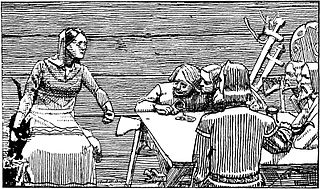
Harald II Greycloak or Grey-hide literally translated was a king of Norway from the Fairhair dynasty.

Magnus Olafsson, better known as Magnus the Good, was King of Norway from 1035 and King of Denmark from 1042, ruling over both countries until his death in 1047.

Olaf III, known as Olaf Kyrre, was king of Norway from 1067 until his death.

The Battle of Stiklestad in 1030 is one of the most famous battles in the history of Norway. In this battle, King Olaf II of Norway was killed. During the pontificate of Pope Alexander III, the Roman Catholic Church declared Olaf a saint in 1164.
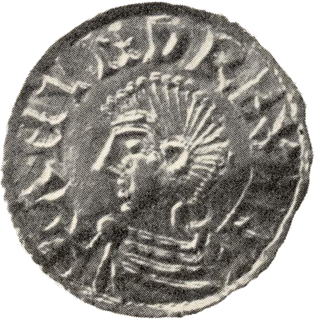
Anund Jacob or James, Swedish: Anund Jakob was King of Sweden from 1022 until around 1050. He is believed to have been born on July 25, in either 1008 or 1010 as Jakob, the son of King Olof Skötkonung and Queen Estrid. Being the second Christian king of the Swedish realm, his long and partly turbulent reign saw the increasing dissemination of Christianity as well as repeated attempts to influence the balance of power in Scandinavia. Through out his regin he tried to subvert the raising Danish hegemony in Scandinavia by supporting the Norwegian monarchy. He also supported the reign of Yaroslav the Wise in Kievan Rus, his brother-in-law. He is referred to in positive terms in German and Norse historical sources. His reign was one of the longest in Sweden during the Viking age and Middle Ages.
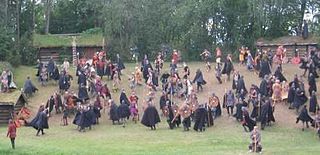
Saint Olav Drama is an outdoor theatre performance played every end of July in Stiklestad in Verdal, Norway.
Guttorm Haraldsson was the first son of King Harald Fairhair of Norway and Åsa, daughter of Håkon Grjotgardsson, who was the first Earl of Lade.

The Battle of Hafrsfjord was a great naval battle fought in Hafrsfjord sometime between 872 and 900 that resulted in the unification of Norway, later known as the Kingdom of Norway. After the battle, the victorious Viking chief Harald Fairhair proclaimed himself the first king of the Norwegians, merging several petty kingdoms under a single monarch for the first time.
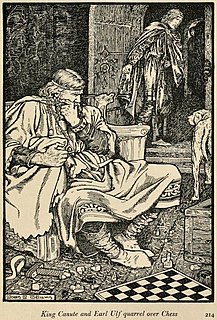
Ulf was a Danish earl (jarl) and regent of Denmark. Ulf was the son of Thorgil Sprakling and the father of King Sweyn II of Denmark and thus the progenitor of the House of Estridsen, which would rule Denmark from 1047 to 1375, which was also sometimes, specially in Swedish sources, referred to as the Ulfinger dynasty to honor him.

Einar Eindridesson Thambarskelfir was an influential Norwegian noble and politician during the 11th century. He headed the feudal lords in their opposition to Olaf Haraldsson.

Thorir Hund was one of the greatest chiefs in Hålogaland. Tore Hund was one of the leaders of the Stiklestad peasant faction opposing Norwegian King Olaf II of Norway, later named St. Olaf. He was reported to have been among the chieftains who killed the king in the Battle of Stiklestad in 1030. He also served in the forces of King Canute the Great on several occasions.

The Battle of Helgeå, or Battle of the Holy River, was a naval engagement which took place in 1026 between joint Danish and English forces and a combined Norwegian and Swedish force, at the estuary of a river called Helge in Sweden.

Finnr Árnason was a Norwegian nobleman and advisor to both King Olaf Haraldsson and King Harald III of Norway and later served King Sweyn II of Denmark. He was the feudal lord (lendmann) of Austrått.

Åsta Gudbrandsdatter was the mother of two Norwegian kings, King Olaf II of Norway and King Harald III of Norway. The primary source for the life of Åsta is Snorri Sturluson's saga Heimskringla, a 13th-century collection of tales about the lives of the Norwegian kings. In the chronicle, Åsta is described as "generous and high-minded" and as a keen political player and guiding influence on her royal husbands and children. Her parents were Gudbrand Kula and Ulfhild.
Svein Knutsson was the son of Cnut the Great, king of Denmark, Norway, and England, and his first wife Ælfgifu of Northampton, a Mercian noblewoman. In 1017 Cnut married Emma of Normandy, but there is no evidence that Ælfgifu was repudiated, and in 1030 Cnut sent her and Svein as regents to rule Norway. However, their rule was considered oppressive by the Norwegians. They imposed new taxes and harsh laws that made them unpopular and they were expelled in 1034.
Bjørn Stallare was an 11th-century Norwegian diplomat and civil servant during the reign of King Olaf II of Norway.
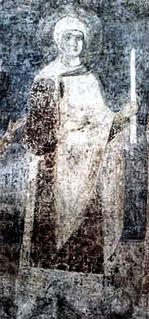
Elisiv of Kiev was a Princess of Kiev and Queen Consort of King Harald III of Norway.

Torstein Knarresmed was a shipwright from Rovde in Sunnmøre in Møre og Romsdal, Norway. He played an important role in the Battle of Stiklestad. His actions probably saved the life of Thorir Hund during the battle leading to a victory over King Olaf II of Norway.
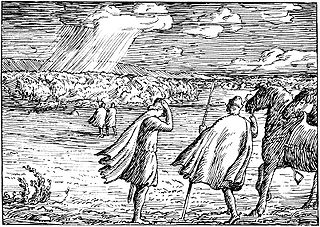
Kálfr Árnason was an 11th-century Norwegian chieftain who played a major role both in defeating King Olaf Haraldsson at the Battle of Stiklestad and in bringing back his young son Magnus and raising him to the throne.
















